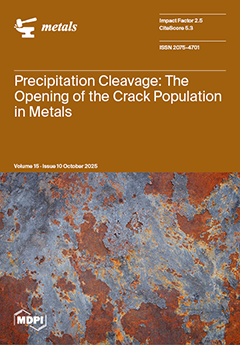The presence of impurities such as Ca, Mg, and Al during the precipitation of rare earths (REs) using ammonium bicarbonate directly affects product purity. It is necessary to optimize precipitation methods and conditions to improve the separation efficiency between REs and impurities. In
[...] Read more.
The presence of impurities such as Ca, Mg, and Al during the precipitation of rare earths (REs) using ammonium bicarbonate directly affects product purity. It is necessary to optimize precipitation methods and conditions to improve the separation efficiency between REs and impurities. In this study, RE (La and Ce) ions were precipitated using ammonium bicarbonate solution, and the separation efficiency of REs from Al, Fe, Ca, and Mg ions was investigated with or without the addition of triammonium citrate (TAC). The results showed that as long as the precipitation yield of REs was controlled below 94%, Ca and Mg ions would not enter the precipitation in the absence of other impurities, and the purity of the obtained rare earth oxides (RE
2O
3) was close to 100%. The presence of Al and Fe impurities would reduce the separation efficiency of REs from Ca and Mg. Therefore, Al and Fe must be separated before the precipitation of REs. First, Fe was completely precipitated by controlling the pH value to 4.12. Then, by filtering out the isolation and adjusting the pH value to 4.6, approximately 84% of Al
3+ was precipitated, with a loss of REs of about 6%. Finally, the pH value was increased to 6.43, and REs were completely precipitated, yielding rare earth carbonate. The RE
2O
3 purity of its calcination product was 97.8% with Al and Mg contents of 1.05% and 0.21%, respectively, and no Ca or Fe was detected. This indicated that Mg can enter the product by co-precipitation with Al. To address this, a small amount of TAC was added during the pre-removal of Fe and Al to facilitate the complete removal of Al. By controlling the precipitation yield of REs at 94%, the purity of the final RE
2O
3 reached 99.6% with an Al content of 0.09%. Furthermore, using a continuous precipitation crystallization method, RE
2O
3 purity can be achieved at 99.8% with an Al content of 0.06%.
Full article





